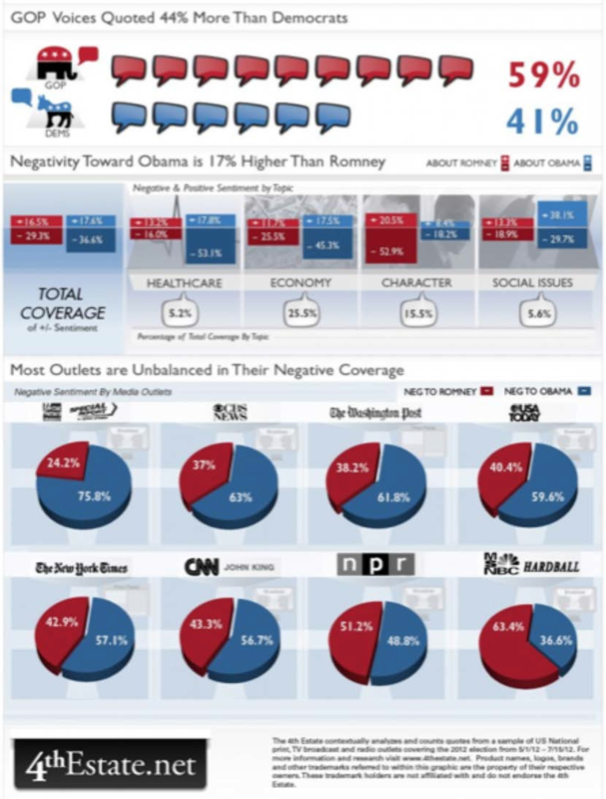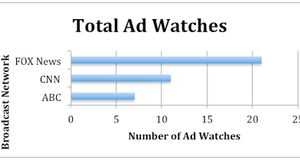From Elon Journal of Undergraduate Research in Communications VOL. 4 NO. 2Public Perceptions of Media Bias: A Meta-Analysis of American Media Outlets During the 2012 Presidential ElectionDiscussionIn the interests of coherency and organization, the discussion of the study's findings will be subsequently divided into five distinct portions; each portion will center on revisiting one of the author's original five research questions. The findings of the study offer a multi-faceted answer to the issues raised in RQ1. Through our analysis of existing bias literature, multiple studies pointed to the "hostile media phenomenon"(Vallone et al., 1985) as one of the primary underlying factors that has allowed for continued social perpetuation of the liberal media bias myth. This theorem provided an expository glimpse into the tendency for citizens to view media coverage of controversial events as unfairly biased and hostile if it does not coincide with the position they advocate. Furthermore, it can be ascertained that individuals who self-identify as being actively involved within the political spectrum (textually referred to as "partisans"), are thus more inclined to perceive the news media's reporting on a specific issue as inflammatory (and therefore, inherently biased) if the given new outlet's coverage directly conflicts with the viewers ideological viewpoint. This innate desire by American consumers for ideological self-validation, if challenged, tends to strengthen their convictions that they and those who identify with their respective ideologies have been (and will continue to be) slandered and manipulated by the so-called "liberal media." However, it must also be acknowledged that the myth surrounding the existence of perceptible media bias is not without some small modicum of truth. Advocates of the existence of said bias commonly cite a number of professional patterns and standards of conduct historically employed by journalists (though are not exclusive to "liberal" journalists) in an effort to manipulate the depiction and depth of information presented each day to the American public. Such techniques discussed included six main types or styles of biases, including; gatekeeping information (i.e. purposefully selecting ideologically reaffirming stories for syndication), employing partisan source selection, omission of (potentially contradictory) facts, manipulating the degree of attention and calculable time devoted to a given issue, and finally, openly displaying narrative, subjective contempt for objective facts. Unfortunately, while the results also indicated a considerable pro-conservative bias amidst the media's collective coverage of the 2012 election, it seems that the degree to which bias can be perceived within the coverage itself remains a subjective entity; however, numerous examples of existing literature indicate that an overwhelming majority of claims inferring partisan biases by the news media remain unsubstantiated, and that mainstream outlet media coverage is predominantly fair and unbiased. Through RQ2, the study aimed to determine to what degree a liberal bias on the part of the news media would affect the political outcome of the electoral process. If one is to proffer a conclusion for this question, one must address the issues raised in this question empirically. As previously stated, the degree and manner to which perceptible bias on the part of the news media can be ascertained remains an overwhelmingly subjective phenomenon, rendering the author unable to offer definitive answer on the subject, even in consideration of strongly supportive data. However, if the author is to examine this question within the parameters of a scientific cause and effect relationship, he is then capable of proffering a more definitive conclusion. In accordance with the patterns gained by analyzing the featured data profiling media outlet's coverage and public opinion polls indicating popular sentiment to be in support of the liberal bias theory (the "cause"), the subsequent effect would hold for the study's defined sample period, namely the 2012 presidential election. In this case, despite existing popular opinion endorsing the existence of the liberal bias theory, the results of this study effectively counteract and (partially) delegitimize these claims. Despite a documented conservative tilt in favor of Mitt Romney and partisan Republican ideology observed in the media's coverage of the election, history shows that President Barack Obama was re-elected for a second term, garnering a 51.1 majority percentage of the popular vote. Even amidst an unfavorable 6:1 ratio of negative to positive coverage and an established pro-conservative tone displayed across all major news media, President Obama was still able to achieve victory. These findings lead to a dual-layered conclusion: That a liberal bias by the American news media stands to affect electoral outcomes can only be ascertained on a select case-by-case basis; and the calculated conservative bias exemplified by the American media did not successfully manipulate the ultimate outcome of the electoral process governing the 2012 presidential election. RQ3 and RQ4 both endeavored to explore whether a systematic partisan media bias could be measured during the span of presidential election campaigns, and whether one political party exists as the subject of overwhelming praiseworthy or negative coverage by the media in comparison to the other. In order to present an accurate and documented conclusion to this question, it seems appropriate to consult the featured info-graphic , which serves as a cumulative representation of the overall coverage patterns exhibited by national media outlets regarding timely campaign issues (see Figure 6). Figure 6. "Liberal Media Bias: Fact or Fiction," 2012.
As evidenced by the numerical collage of results offered in Figure 6, throughout the course of the election, the news media curtailed their overall depth of electoral coverage so as to feature statements originating from partisan Republican officials at a 44% higher rate than those from partisan Democratic officials. Additionally, the overall calculated ratio of positive to negative coverage indicates that outlets across all three major mediums were 17.1% more critical of Obama than Romney. These results indicate overwhelmingly that the existence of a discernible liberal bias cannot be logically associated with the overall electoral coverage patterns and images displayed by the mainstream media during the course of the 2012 presidential election, thus affirming another of the researcher's original hypotheses offered at the onset of this study. The author's fifth and final research question sought to explore as to whether the existence of a discernible bias would vary from campaign to campaign or medium to medium. While previously discussed in the research and findings portion of this thesis, it seems that the most logical foundation of bias can be found in the analysis of medium vs. medium electoral coverage. The data presented in Figures 2, 3, 4 and 6 indicated the Romney campaign boasted a greater percentage of electoral coverage, averaging an increase 44% more media attention than the Obama campaign across all major news information mediums. And while the possibility for the existence of campaign-based bias may exist, it has not been thoroughly examined enough within the research implications of this study for the author to offer a substantiated conclusion. Research LimitationsThe author acknowledges that the considerably limited scope of the accumulated results and the consistent reliance on selected sources to provide the bulk of the study's statistical basis does not permit him to speak indisputably about either the source or the depth of the perceptual bias this paper has sought to document. Meta-analyses are by nature somewhat subjective, and are typically limited in their academic scope to primarily reviewing and analyzing quantitative studies, even though qualitative research stands to provide measurable insight into the research issue being studied. Furthermore, the conclusions garnered by metaanalyses often conflict if different studies are sampled or excluded for different reasons (in essence, researchers who craft meta-analyses can base the entirety of their argument off an unrepresentative sample of the topic being examined). Despite the prevalence of American consumers obtaining a veritable portion of their news via aggregate content sites, many scholars now attribute the overwhelming functionality of the American political blogosphere to be that of an open avenue for the exchange of partisan-influenced ideas and opinions that primarily stand to reaffirm existing conservative or liberal belief systems and ideological self-validation. This means that print and online editorials, opinion columns, letters to the editor and other subjective-based content sites (including content featured on popular political news aggregate blogs and websites like the Huffington Post, Drudge Report or Christian Science Monitor), which do not reflect an open and unwavering commitment to objectivity in their news reporting, were thus excluded from the analysis. Therefore, the conclusions drawn through analysis of the accumulated data are limited to the coverage of traditional news media, including television, print and radio. Throughout the discussion of the empirical results below, aggregated results from analyzed newspapers, television and radio broadcasts are presented in order to give the reader a more concise understanding of the profiled outlets and issues presented.Continued on Next Page » Suggested Reading from Inquiries Journal
Inquiries Journal provides undergraduate and graduate students around the world a platform for the wide dissemination of academic work over a range of core disciplines. Representing the work of students from hundreds of institutions around the globe, Inquiries Journal's large database of academic articles is completely free. Learn more | Blog | Submit Latest in Business & Communications |




















